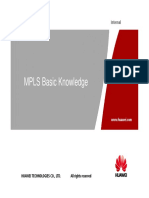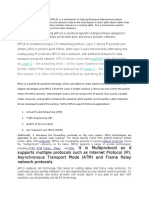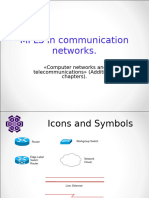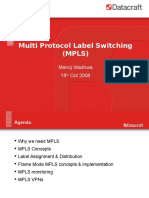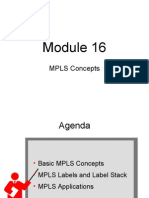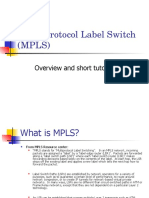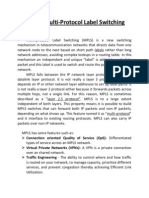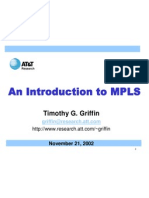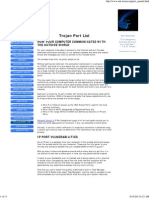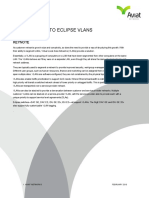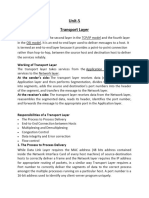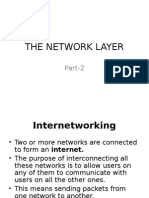01-01 MPLS Basics
Uploaded by
krajdyal01-01 MPLS Basics
Uploaded by
krajdyalS5700 and S6700 Series Ethernet Switches
Configuration Guide - MPLS 1 MPLS Basics
1 MPLS Basics
1.1 Overview of MPLS
1.2 Understanding MPLS
1.3 Application Scenarios for MPLS
1.1 Overview of MPLS
Definition
The Multiprotocol Label Switching (MPLS) protocol is used on Internet Protocol
(IP) backbone networks. MPLS uses connection-oriented label switching on
connectionless IP networks. By combining Layer 3 routing technologies and Layer
2 switching technologies, MPLS leverages the flexibility of IP routing and the
simplicity of Layer 2 switching.
MPLS is based on Internet Protocol version 4 (IPv4). The core MPLS technology
can be extended to multiple network protocols, such as Internet Protocol version 6
(IPv6), Internet Packet Exchange (IPX), and Connectionless Network Protocol
(CLNP). "Multiprotocol" in MPLS means that multiple network protocols are
supported.
MPLS is used for tunneling but not a service or an application. MPLS supports
multiple protocols and services. Moreover, it ensures security of data transmission.
Purpose
IP-based routing serves well on the Internet in the mid 90s, but IP technology can
be inefficient at forwarding packets because software must search for routes using
the longest match algorithm. As a result, the forwarding capability of IP
technology can act as a bottleneck.
In contrast, Asynchronous transfer mode (ATM) technology uses labels of fixed
length and maintains a label table that is much smaller than a routing table.
Compared to IP, ATM is more efficient at forwarding packets. ATM is a complex
protocol, however, with high deployment costs, that hinder its widespread use.
Issue 06 (2022-01-26) Copyright © Huawei Technologies Co., Ltd. 1
S5700 and S6700 Series Ethernet Switches
Configuration Guide - MPLS 1 MPLS Basics
Because traditional IP technology is simple and costs little to deploy, a
combination of IP and ATM capabilities would be ideal. This has sparked the
emergence of MPLS technology.
MPLS was created to increase forwarding rates. Unlike IP routing and forwarding,
MPLS analyzes a packet header only on the edge of the network and not at each
hop. MPLS therefore reduces packet processing time.
The use of hardware-based functions based on application-specific integrated
circuits (ASICs) has made IP routing far more efficient, so MPLS is no longer
needed for its high-speed forwarding advantages. However, MPLS supports multi-
layer labels, and its forwarding plane is connection-oriented. For these reasons,
MPLS is widely used for virtual private network (VPN), traffic engineering (TE),
and quality of service (QoS).
1.2 Understanding MPLS
1.2.1 Basic MPLS Architecture
MPLS Network Structure
Figure 1-1 shows a typical MPLS network structure. Packets are forwarded on an
MPLS network based on labels. In Figure 1-1, network devices that swap MPLS
labels and forward packets are label switching routers (LSRs), which form an
MPLS domain. LSRs that reside at the edge of the MPLS domain and connect to
other networks are called label edge routers (LERs), and LSRs within the MPLS
domain are core LSRs.
Figure 1-1 MPLS network structure
When IP packets reach an MPLS network, the ingress LER analyzes the packets
and then adds appropriate labels to them. All LSRs on the MPLS network forward
packets based on labels. When IP packets leave the MPLS network, the egress LER
pops the labels.
Issue 06 (2022-01-26) Copyright © Huawei Technologies Co., Ltd. 2
S5700 and S6700 Series Ethernet Switches
Configuration Guide - MPLS 1 MPLS Basics
A path along which IP packets are transmitted on an MPLS network is called a
label switched path (LSP). An LSP is a unidirectional path in the same direction
data packets traverse.
As shown in Figure 1-1, the LER at the starting point of an LSP is the ingress
node, and the LER at the end of the LSP is the egress node. The LSRs between the
ingress node and egress node along the LSP are transit nodes. An LSP may have
zero, one, or several transit nodes and only one ingress node and one egress node.
On an LSP, MPLS packets are sent from the ingress to the egress. In this
transmission direction, the ingress node is the upstream node of the transit nodes,
and the transit nodes are the downstream nodes of the ingress node. Similarly,
transit nodes are the upstream nodes of the egress node, and the egress node is
the downstream node of the transit nodes.
MPLS Architecture
Figure 1-2 shows the MPLS architecture, which consists of a control plane and a
forwarding plane.
Figure 1-2 MPLS architecture
The MPLS architecture has the following parts:
● Control plane: generates and maintains routing and label information
– Routing information base (RIB): is generated by IP routing protocols and
used to select routes.
– Label distribution protocol (LDP): allocates labels, creates a label
information base (LIB), and establishes and tears down LSPs.
– Label information base (LIB): is generated by LDP and used to manage
labels.
● Forwarding plane (data plane): forwards IP packets and MPLS packets
– Forwarding information base (FIB): is generated based on routing
information obtained from the RIB and used to forward common IP
packets.
Issue 06 (2022-01-26) Copyright © Huawei Technologies Co., Ltd. 3
S5700 and S6700 Series Ethernet Switches
Configuration Guide - MPLS 1 MPLS Basics
– Label forwarding information base (LFIB): is created by LDP on an LSR
and used to forward MPLS packets.
1.2.2 MPLS Label
Forwarding Equivalence Class
A forwarding equivalence class (FEC) is a collection of packets with the same
characteristics. Packets of the same FEC are forwarded in the same way on an
MPLS network.
FECs can be identified by the source address, destination address, source port,
destination port, and VPN. For example, in IP forwarding, packets matching the
same route based on the longest match algorithm belong to an FEC.
Label
A label is a short, fixed-length (4 bytes) identifier that is only locally significant. A
label identifies an FEC to which a packet belongs. In some cases, such as load
balancing, a FEC can be mapped to multiple incoming labels. Each label, however,
represents only one FEC on a device.
Compared with an IP packet, an MPLS packet has the additional 4-byte MPLS
label. The MPLS label is between the link layer header and the network layer
header, and allows use of any link layer protocol. Figure 1-3 shows position of an
MPLS label and fields in the MPLS label.
Figure 1-3 MPLS label encapsulation format
An MPLS label contains the following fields:
● Label: 20-bit label value.
● Exp: 3-bit, used as an extension value. Generally, this field is used as the class
of service (CoS) field. When congestion occurs, devices prioritize packets that
have a larger value in this field.
● S: 1-bit value indicating the bottom of a label stack. MPLS supports nesting of
multiple labels. When the S field is 1, the label is at the bottom of the label
stack.
● TTL: time to live. This 8-bit field is the same as the TTL field in IP packets.
A label stack is an arrangement of labels. In Figure 1-4, the label next to the
Layer 2 header is the top of the label stack (outer MPLS label), and the label next
Issue 06 (2022-01-26) Copyright © Huawei Technologies Co., Ltd. 4
S5700 and S6700 Series Ethernet Switches
Configuration Guide - MPLS 1 MPLS Basics
to the Layer 3 header is the bottom of the label stack (inner MPLS label). An
MPLS label stack can contain an unlimited number of labels. Currently, MPLS label
stacks can be applied to MPLS VPN and Traffic Engineering Fast ReRoute (TE
FRR).
Figure 1-4 Label stack
The label stack organizes labels according to the rule of Last-In, First-Out. The
labels are processed from the top of the stack.
Label Space
The label space is the value range of the label, and the space is organized in the
following ranges:
● 0 to 15: special labels. For details about special labels, see Table 1-1.
● 16 to 1023: label space shared by static LSPs and static constraint-based
routed LSPs (CR-LSPs).
● 1024 or above: label space for dynamic signaling protocols, such as Label
Distribution Protocol (LDP), Resource Reservation Protocol-Traffic Engineering
(RSVP-TE), and MultiProtocol Border Gateway Protocol (MP-BGP).
Table 1-1 Special labels
Label Value Label Description
0 IPv4 Explicit The label must be popped out (removed), and the
NULL Label packets must be forwarded based on IPv4. If the
egress node allocates a label with the value of 0
to the penultimate hop LSR, the penultimate hop
LSR pushes label 0 to the top of the label stack
and forwards the packet to the egress node.
When the egress node detects that the label of
the packet is 0, the egress node pops the label
out.
1 Router Alert A label that is only valid when it is not at the
Label bottom of a label stack. The label is similar to the
Router Alert Option field in IP packets. After
receiving such a label, the node sends it to a local
software module for further processing. Packet
forwarding is determined by the next-layer label.
If the packet needs to be forwarded continuously,
the node pushes the Router Alert Label to the top
of the label stack again.
Issue 06 (2022-01-26) Copyright © Huawei Technologies Co., Ltd. 5
S5700 and S6700 Series Ethernet Switches
Configuration Guide - MPLS 1 MPLS Basics
Label Value Label Description
2 IPv6 Explicit The label must be popped out, and the packets
NULL Label must be forwarded based on IPv6. If the egress
node allocates a label with the value of 2 to the
LSR at the penultimate hop, the LSR pushes label
2 to the top of the label stack and forwards the
packet to the egress node. When the egress node
recognizes that the value of the label carried in
the packet is 2, the egress node immediately pops
it out.
3 Implicit When the label with the value of 3 is swapped on
NULL Label an LSR at the penultimate hop, the LSR pops the
label out and forwards the packet to the egress
node. Upon receiving the packet, the egress node
forwards the packet in IP forwarding mode or
according to the next layer label.
4 to 13 Reserved None.
14 OAM Router A label for operation, administration and
Alert Label maintenance (OAM) packets over an MPLS
network. MPLS OAM sends OAM packets to
monitor LSPs and report faults. OAM packets are
transparent on transit nodes and the penultimate
LSR.
15 Reserved None.
1.2.3 LSP Setup
Before forwarding packets, MPLS must allocate labels to packets and establish an
LSP. LSPs can be either static or dynamic.
Establishing Static LSPs
You can manually allocate labels to set up static LSPs. A static LSP is valid for only
the local node, and nodes on the LSP are unaware of the entire LSP.
A static LSP is set up without any label distribution protocols or exchange of
control packets. Static LSPs have low costs and are recommended for small-scale
networks with simple and stable topologies. Static LSPs cannot adapt to network
topology changes and must be configured by an administrator.
Establishing Dynamic LSPs
Label Distribution Protocols for Dynamic LSPs
Dynamic LSPs are established using label distribution protocols. As the control
protocol or signaling protocol for MPLS, a label distribution protocol defines FECs,
distributes labels, and establishes and maintains LSPs.
MPLS can use the following protocols for label distribution:
Issue 06 (2022-01-26) Copyright © Huawei Technologies Co., Ltd. 6
S5700 and S6700 Series Ethernet Switches
Configuration Guide - MPLS 1 MPLS Basics
● LDP
The Label Distribution Protocol (LDP) is designed for distributing labels. It sets
up an LSP hop by hop according to Interior Gateway Protocol (IGP) and
Border Gateway Protocol (BGP) routing information.
For details about LDP implementation, see Understanding MPLS LDP in the 3
MPLS LDP Configuration.
● RSVP-TE
Resource Reservation Protocol Traffic Engineering (RSVP-TE) is an extension
of RSVP and is used to set up a constraint-based routed LSP (CR-LSP). In
contrast to LDP LSPs, RSVP-TE tunnels are characterized by bandwidth
reservation requests, bandwidth constraints, link "colors" (designating
administrative groups), and explicit paths.
For details about RSVP-TE implementation, see Understanding MPLS TE in the
5 MPLS TE Configuration.
● MP-BGP
MP-BGP is an extension to BGP and allocates labels to MPLS VPN routes and
inter-AS VPN routes.
For details about MP-BGP implementation, see BGP Configuration in the
S2720, S5700, and S6700 V200R019C00 Configuration Guide - IP Unicast
Routing.
Procedure for Establishing Dynamic LSPs
MPLS labels are distributed from downstream LSRs to upstream LSRs. As shown in
Figure 1-5, a downstream LSR identifies FECs based on the IP routing table,
allocates a label to each FEC, and records the mapping between labels and FECs.
The downstream LSR then encapsulates the mapping into a message and sends
the message to the upstream LSR. As this process proceeds on all the LSRs, the
LSRs create a label forwarding table and establish an LSP.
Figure 1-5 Establishing a dynamic LSP
1.2.4 MPLS Forwarding
MPLS Forwarding Process
Basic Concepts
Label operations involved in MPLS packet forwarding include push, swap, and pop:
Issue 06 (2022-01-26) Copyright © Huawei Technologies Co., Ltd. 7
S5700 and S6700 Series Ethernet Switches
Configuration Guide - MPLS 1 MPLS Basics
● Push: When an IP packet enters an MPLS domain, the ingress node adds a
new label to the packet between the Layer 2 header and the IP header.
Alternatively, an LSR adds a new label to the top of the label stack.
● Swap: When a packet is transferred within the MPLS domain, a local node
swaps the label at the top of the label stack in the MPLS packet for the label
allocated by the next hop according to the label forwarding table.
● Pop: When a packet leaves the MPLS domain, the label is popped out of
(removed from) the MPLS packet.
A label is invalid at the last hop of an MPLS domain. The penultimate hop
popping (PHP) feature applies. On the penultimate node, the label is popped
out of the packet to reduce the size of the packet that is forwarded to the last
hop. Then, the last hop directly forwards the IP packet or forwards the packet
by using the second label.
By default, PHP is configured on the egress node. The egress node supporting
PHP allocates the label with the value of 3 to the penultimate hop.
Basic Forwarding Process
LSPs that support PHP are used in the following example to describe how MPLS
packets are forwarded.
Figure 1-6 Basic MPLS forwarding process
As shown in Figure 1-6, the LSRs have distributed MPLS labels and set up an LSP
with the destination address of 4.4.4.2/32. MPLS packets are forwarded as follows:
1. The ingress node receives an IP packet destined for 4.4.4.2. Then, the ingress
node adds Label Z to the packet and forwards it.
2. When the downstream transit node receives the labeled packet, the node
replaces Label Z by Label Y.
3. When the transit node at the penultimate hop receives the packet with Label
Y, the node pops out Label Y because the label value is 3. The transit node
then forwards the packet to the egress node as an IP packet.
4. The egress node receives the IP packet and forwards it to 4.4.4.2/32.
Issue 06 (2022-01-26) Copyright © Huawei Technologies Co., Ltd. 8
S5700 and S6700 Series Ethernet Switches
Configuration Guide - MPLS 1 MPLS Basics
Detailed MPLS Packet Forwarding Process
Basic Concepts
The following entities are used in MPLS packet forwarding:
● Tunnel ID
Each tunnel is assigned a unique ID to ensure that upper layer applications
(such as VPN and route management) on a tunnel use the same interface.
The tunnel ID is 32 bits long and is valid only on the local end.
● NHLFE
A next hop label forwarding entry (NHLFE) is used to guide MPLS packet
forwarding.
An NHLFE specifies the tunnel ID, outbound interface, next hop, outgoing
label, and label operation.
FEC-to-NHLFE (FTN) maps each FEC to a group of NHLFEs. An FTN can be
obtained by searching for tunnel IDs that are not 0x0 in a FIB. The FTN is
available on the ingress only.
● ILM
The incoming label map (ILM) maps each incoming label to a group of
NHLFEs.
The ILM specifies the tunnel ID, incoming label, inbound interface, and label
operation.
The ILM on a transit node identifies bindings between labels and NHLFEs.
Similar a FIB that provides forwarding information based on destination IP
addresses, the ILM provides forwarding information based on labels.
Detailed Forwarding Process
Figure 1-7 Detailed MPLS packet forwarding process
Issue 06 (2022-01-26) Copyright © Huawei Technologies Co., Ltd. 9
S5700 and S6700 Series Ethernet Switches
Configuration Guide - MPLS 1 MPLS Basics
Figure 1-7 shows the detailed MPLS packet forwarding process.
When an IP packet enters an MPLS domain, the ingress node searches the FIB to
check whether the tunnel ID matching the destination IP address is 0x0.
● If the tunnel ID is 0x0, the packet is forwarded along the IP link.
● If the tunnel ID is not 0x0, the packet is forwarded along an LSP.
During MPLS forwarding, LSRs find the matching FIB entries, ILM entries, and
NHLFEs for MPLS packets based on tunnel IDs.
● The ingress node processes MPLS packets as follows:
a. Searches the FIB to find the tunnel ID matching the destination IP
address.
b. Finds the NHLFE matching the tunnel ID in the FIB and associates the FIB
entry with the NHLFE entry.
c. Checks the NHLFE to obtain the outbound interface, next hop, outgoing
label, and label operation.
d. Pushes the label into IP packets, processes the EXP field according to QoS
policy, and processes the TTL field, and then sends the encapsulated
MPLS packets to the next hop.
NOTE
For details on how the ingress node processes the EXP field and TTL field, see
Understanding MPLS QoS in the 4 MPLS QoS Configuration and Processing
MPLS TTL.
● A transit node processes MPLS packets as follows:
a. Finds the ILM matching the MPLS label to obtain the Tunnel ID.
b. Finds the NHLFE matching the Tunnel ID in the ILM.
c. Checks the NHLFE to obtain the outbound interface, next hop, outgoing
label, and label operation.
d. Processes the MPLS packets according to the label value:
▪ If the label value is greater than or equal to 16, the transit node
replaces the label with a new label replaces and processes the EXP
field and TTL field. After that, the transit node forwards the MPLS
packet with the new label to the next hop.
▪ If the label value is 3, the transit node pops out the label and
processes the EXP field and TTL field. After that, the transit node
forwards the packets through an IP route or based on the next layer
label.
● The egress node forwards MPLS packets based on the ILM and forwards IP
packets based on the routing table
– When the egress node receives IP packets, it checks the FIB and performs
IP forwarding.
– When the egress node receives MPLS packets, it checks the ILM for the
label operation and processes the EXP field and TTL field.
▪ When the S flag in the label is 1, the label is at the bottom of the
label stack, and the packet is directly forwarded through an IP route.
Issue 06 (2022-01-26) Copyright © Huawei Technologies Co., Ltd. 10
S5700 and S6700 Series Ethernet Switches
Configuration Guide - MPLS 1 MPLS Basics
▪ When the S field in the label is 0, a next-layer label exists, and the
packet is forwarded based on the next layer label.
MPLS TTL Processing
This section describes how MPLS processes the TTL and responds to TTL timeout.
MPLS TTL Processing Modes
The TTL field in an MPLS label is 8 bits long. The TTL field is the same as that in
an IP packet header. MPLS processes the TTL to prevent loops and implement
traceroute.
RFC 3443 defines two modes in which MPLS can process the TTL in MPLS packets:
Uniform and Pipe modes. By default, MPLS processes the TTL in Uniform mode.
The two modes work as follows:
● Uniform mode
When IP packets enter an MPLS network, the ingress node decreases the IP
TTL by one and copies this new value to the MPLS TTL field. The TTL field in
MPLS packets is processed in standard mode. The egress node decreases the
MPLS TTL by one and maps this new value to the IP TTL field. Figure 1-8
shows how the TTL field is processed on the transmission path.
Figure 1-8 TTL processing in Uniform mode for incoming traffic
● Pipe mode
As shown in Figure 1-9, the ingress node decreases the IP TTL by one and the
MPLS TTL remains constant. The TTL field in MPLS packets is processed in
standard mode. The egress node decreases the IP TTL by one. In Pipe mode,
the IP TTL only decreases by one on the ingress node and one on the egress
node when packets travel across an MPLS network.
Issue 06 (2022-01-26) Copyright © Huawei Technologies Co., Ltd. 11
S5700 and S6700 Series Ethernet Switches
Configuration Guide - MPLS 1 MPLS Basics
Figure 1-9 TTL processing in Pipe mode for incoming traffic
In MPLS VPN applications, the MPLS backbone network needs to be shielded to
ensure network security. The Pipe mode is recommended for private network
packets.
ICMP Response Packet
On an MPLS network, when an LSR receives an MPLS packet with the TTL value of
1, the LSR generates an Internet Control Message Protocol (ICMP) response
packet.
The LSR returns the ICMP response packet to the sender in the following ways:
● If the LSR has a reachable route to the sender, the LSR directly sends the
ICMP response packet to the sender through the IP route.
● If the LSR has no reachable route to the sender, the LSR forwards the ICMP
response packet along the LSP. The egress node forwards the ICMP response
packet to the sender.
In most cases, the received MPLS packet contains only one label and the LSR
responds to the sender with the ICMP response packet using the first method. If
the MPLS packet contains multiple labels, the LSR uses the second method.
The MPLS VPN packets may contain only one label when they arrive at an
autonomous system boundary router (ASBR) on the MPLS VPN. These devices
have no IP routes to the sender, so they use the second method to reply to the
ICMP response packets.
1.2.5 LSP Connectivity Check
Introduction to LSP Connectivity Check
On an MPLS network, the control panel used for setting up an LSP cannot detect
the failure in data forwarding of the LSP. This makes network maintenance
difficult. The MPLS ping and tracert mechanisms detect LSP errors and locate
faulty nodes.
Issue 06 (2022-01-26) Copyright © Huawei Technologies Co., Ltd. 12
S5700 and S6700 Series Ethernet Switches
Configuration Guide - MPLS 1 MPLS Basics
MPLS ping is used to check network connectivity. MPLS tracert is used to check
the network connectivity, and to locate network faults. Similar to IP ping and
tracert, MPLS ping and tracert use MPLS echo request packets and MPLS echo
reply packets to check LSP availability. MPLS echo request packets and echo reply
packets are both encapsulated into User Datagram Protocol (UDP) packets. The
UDP port number of the MPLS echo request packet is 3503, which can be
identified only by MPLS-enabled devices.
An MPLS echo request packet carries FEC information to be detected, and is sent
along the same LSP as other packets with the same FEC. In this manner, the
connectivity of the LSP is checked. MPLS echo request packets are forwarded to
the destination end using MPLS, while MPLS echo reply packets are forwarded to
the source end using IP. Routers set the destination address in the IP header of the
MPLS echo request packets to 127.0.0.1/8 (local loopback address) and the TTL
value is 1. In this way, MPLS echo request packets are not forwarded using IP
forwarding when the LSP fails so that the failure of the LPS can be detected.
MPLS Ping
Figure 1-10 MPLS network
As shown in Figure 1-10, LSR_1 establishes an LSP to LSR_4. LSR_1 performs MPLS
ping on the LSP by performing the following steps:
1. LSR_1 checks whether the LSP exists. (On a TE tunnel, the router checks
whether the tunnel interface exists and the CR-LSP has been established.) If
the LSP does not exist, an error message is displayed and the MPLS ping
stops. If the LSP exists, LSR_1 performs the following operations.
2. LSR_1 creates an MPLS echo request packet and adds 4.4.4.4 to the
destination FEC in the packet. In the IP header of the MPLS echo request
packet, the destination address is 127.0.0.1/8 and the TTL value is 1. LSR_1
searches for the corresponding LSP, adds the LSP label to the MPLS echo
request packet, and sends the packet to LSR_2.
3. Transit nodes LSR_2 and LSR_3 forward the MPLS echo request packet based
on MPLS. If MPLS forwarding on a transit node fails, the transit node returns
an MPLS echo reply packet carrying the error code to LSR_1.
4. If no fault exists along the MPLS forwarding path, the MPLS echo request
packet reaches the LSP egress node LSR_4. LSR_4 returns a correct MPLS echo
reply packet after verifying that the destination IP address 4.4.4.4 is the
loopback interface address. MPLS ping is complete.
Issue 06 (2022-01-26) Copyright © Huawei Technologies Co., Ltd. 13
S5700 and S6700 Series Ethernet Switches
Configuration Guide - MPLS 1 MPLS Basics
MPLS Tracert
As shown in Figure 1-10, LSR_1 performs MPLS tracert on LSR_4 (4.4.4.4/32) by
performing the following steps:
1. LSR_1 checks whether an LSP exists to LSR_4. (On a TE tunnel, the router
checks whether the tunnel interface exists and the CR-LSP has been
established.) If the LSP does not exist, an error message is displayed and the
tracert stops. If the LSP exists, LSR_1 performs the following operations.
2. LSR_1 creates an MPLS echo request packet and adds 4.4.4.4 to the
destination FEC in the packet. In the IP header of the MPLS echo request
packet, the destination address is 127.0.0.1/8. Then LSR_1 adds the LSP label
to the packet, sets the MPLS TTL value to 1, and sends the packet to LSR_2.
The MPLS echo request packet contains a downstream mapping type-length-
value (TLV) that carries downstream information about the LSP at the current
node, such as next-hop address and outgoing label.
3. Upon receiving the MPLS echo request packet, LSR_2 decreases the MPLS TTL
by one and finds that TTL times out. LSR_2 then checks whether the LSP
exists and the next-hop address and whether the outgoing label of the
downstream mapping TLV in the packet is correct. If so, LSR_2 returns a
correct MPLS echo reply packet that carries the downstream mapping TLV of
LSR_2. If not, LSR_2 returns an incorrect MPLS echo reply packet.
4. After receiving the correct MPLS echo reply packet, LSR_1 resends the MPLS
echo request packet that is encapsulated in the same way as step 2 and sets
the MPLS TTL value to 2. The downstream mapping TLV of this MPLS echo
request packet is replicated from the MPLS echo reply packet. LSR_2 performs
common MPLS forwarding on this MPLS echo request packet. If TTL times out
when LSR_3 receives the MPLS echo request packet, LSR_3 processes the
MPLS echo request packet and returns an MPLS echo reply packet in the same
way as step 3.
5. After receiving a correct MPLS echo reply packet, LSR_1 repeats step 4, sets
the MPLS TTL value to 3, replicates the downstream mapping TLV in the
MPLS echo reply packet, and sends the MPLS echo request packet. LSR_2 and
LSR_3 perform common MPLS forwarding on this MPLS echo request packet.
Upon receiving the MPLS echo request packet, LSR_4 repeats step 3 and
verifies that the destination IP address 4.4.4.4 is the loopback interface
address. LSR_4 returns an MPLS echo reply packet that does not carry the
downstream mapping TLV. MPLS tracert is complete.
When routers return the MPLS echo reply packet that carries the downstream
mapping TLV, LSR_1 obtains information about each node along the LSP.
1.3 Application Scenarios for MPLS
1.3.1 MPLS VPN
Traditional VPNs transmit private network data over the public network using
tunneling protocols, such as the Generic Routing Encapsulation (GRE), Layer 2
Tunneling Protocol (L2TP), and Point to Point Tunneling Protocol (PPTP). MPLS
LSPs are set up by swapping labels, and data packets are not encapsulated or
encrypted. Therefore, MPLS is an appropriate technology for VPN implementation.
Issue 06 (2022-01-26) Copyright © Huawei Technologies Co., Ltd. 14
S5700 and S6700 Series Ethernet Switches
Configuration Guide - MPLS 1 MPLS Basics
MPLS VPN can build a private network with security similar to a Frame Relay (FR)
network. On MPLS VPN networks, customer devices do not need to set up tunnels
such as GRE and L2TP tunnels, so the network delay is minimized.
As shown in Figure 1-11, the MPLS VPN connects private network branches
through LSPs to form a unified network. The MPLS VPN also controls the
interconnection between VPNs. Figure 1-11 shows the devices on an MPLS VPN
network.
● A customer edge (CE) is deployed on the edge of a customer network. It can
be a router, a switch, or a host.
● A provider edge (PE) is deployed on the edge of an IP/MPLS backbone
network.
● A provider (P) device on an IP/MPLS backbone network is not directly
connected to CEs. The provider device only needs to provide basic MPLS
forwarding capabilities and does not maintain VPN information.
Figure 1-11 MPLS VPN
An MPLS VPN has the following characteristics:
● PEs manage VPN users, set up LSPs between PEs, and advertise routing
information between users in a VPN.
● PEs use MP-BGP to advertise VPN routing information.
● The MPLS-based VPN supports IP address multiplexing between sites as well
as the interconnection of different VPNs.
1.3.2 MPLS TE
On traditional IP networks, routers select the shortest path as the route regardless
of other factors such as bandwidth. Traffic on a path is not switched to other
paths even if the path is congested. As a result, the shortest path first rule can
cause severe problems on networks.
Traffic engineering (TE) monitors network traffic and the load of network
components and then adjusts parameters such as traffic management, routing,
and resource restraint parameters in real time. These adjustments help prevent
network congestion caused by unbalanced traffic distribution.
Issue 06 (2022-01-26) Copyright © Huawei Technologies Co., Ltd. 15
S5700 and S6700 Series Ethernet Switches
Configuration Guide - MPLS 1 MPLS Basics
TE can be implemented on a large-scale backbone network using a simple,
scalable solution. MPLS, an overlay model, allows a virtual topology to be
established over a physical topology and maps traffic to the virtual topology.
MPLS can be integrated with TE to implement MPLS TE.
As shown in Figure 1-12, two paths are set up between LSR_1 and LSR_7: LSR_1 -
> LSR_2 -> LSR_3 -> LSR_6 -> LSR_7 and LSR_1 -> LSR_2 -> LSR_4 -> LSR_5 ->
LSR_6 -> LSR_7. Bandwidth of the first path is 30 Mbit/s, and bandwidth of the
second path is 80 Mbit/s. TE allocates traffic based on bandwidth, preventing link
congestion. For example, 30 Mbit/s and 50 Mbit/s services are running between
LSR_1 and LSR_7. TE distributes the 30 Mbit/s traffic to the 30 Mbit/s path and the
50 Mbit/s traffic to the 80 Mbit/s path.
Figure 1-12 MPLS TE
MPLS TE can reserve resources by setting up LSPs along a specified path to
prevent network congestion and balance network traffic. MPLS TE has the
following advantages:
● MPLS TE can reserve resources to ensure the quality of services during the
establishment of LSPs.
● The behavior of an LSP can be easily controlled based on the attributes of the
LSP such as priority and bandwidth.
● LSP establishment consumes few resources and does not affect other network
services.
● Backup path and fast reroute (FRR) protect network communication upon a
failure of a link or a node.
These advantages make MPLS TE the optimal TE solution. MPLS TE allows service
providers (SPs) to fully leverage existing network resources to provide diverse
services, optimize network resources, and efficiently manage the network.
1.3.3 MPLS 6PE
IPv6 Provider Edge (6PE) is an IPv4-to-IPv6 transition technology. This technology
allows ISPs to provide access services for scattered IPv6 networks over existing
Issue 06 (2022-01-26) Copyright © Huawei Technologies Co., Ltd. 16
S5700 and S6700 Series Ethernet Switches
Configuration Guide - MPLS 1 MPLS Basics
IPv4 backbone networks. In this way, CEs on IPv6 islands can communicate with
each other through IPv4 PEs.
On an MPLS 6PE network shown in Figure 1-13:
● 6PE routers exchange IPv6 routing information with CEs using IPv6 routing
protocols.
● 6PE routers exchange IPv6 routing information with each other using
Multiprotocol Border Gateway Protocol (MP-BGP) and allocate MPLS labels to
IPv6 prefixes.
● 6PE routers exchange IPv4 routing information with Ps using IPv4 routing
protocols and establish LSPs between 6PE routers and Ps using MPLS.
Figure 1-13 Packet forwarding using MPLS 6PE
Figure 1-13 shows the IPv6 packet forwarding process on an MPLS 6PE network.
IPv6 packets must carry outer and inner labels when being forwarded on the IPv4
backbone network. The inner label (L2) maps the IPv6 prefix, while the outer label
(L1) maps the LSP between 6PEs.
The MPLS 6PE technology allows ISPs to connect existing IPv4/MPLS networks to
IPv6 networks by simply upgrading PEs. To Internet service providers (ISPs), the
MPLS 6PE technology is an efficient solution for transition to IPv6.
Issue 06 (2022-01-26) Copyright © Huawei Technologies Co., Ltd. 17
You might also like
- Understanding MPLS: A Comprehensive GuideNo ratings yetUnderstanding MPLS: A Comprehensive Guide6 pages
- 01 MPLS Implementation and ConfigurationNo ratings yet01 MPLS Implementation and Configuration39 pages
- Exfo Anote264 Netblazer Mpls Basics Testing enNo ratings yetExfo Anote264 Netblazer Mpls Basics Testing en4 pages
- Overview of MPLS Basic Operation and in Depth Config Part 1590764138100% (1)Overview of MPLS Basic Operation and in Depth Config Part 1590764138150 pages
- MPLS Fundamentals and MPLS L2/L3 VPN Concepts.: AgendaNo ratings yetMPLS Fundamentals and MPLS L2/L3 VPN Concepts.: Agenda10 pages
- Internet Protocol/Multiprotocol Label Switching (Ip/Mpls) NetworksNo ratings yetInternet Protocol/Multiprotocol Label Switching (Ip/Mpls) Networks13 pages
- Nepal Telecom Exam Preparation (Level 7) : Dipak Kumar NidhiNo ratings yetNepal Telecom Exam Preparation (Level 7) : Dipak Kumar Nidhi22 pages
- MPLS Introduction: Multi-Protocol Label SwitchingNo ratings yetMPLS Introduction: Multi-Protocol Label Switching50 pages
- CS 520 - Fall 2003 - Lecture 15 MPLS and Its Applications (With Modifications For CS 520)No ratings yetCS 520 - Fall 2003 - Lecture 15 MPLS and Its Applications (With Modifications For CS 520)76 pages
- Multi Protocol Label Switching (MPLS) : Manoj Wadhwa 18 Oct 2008No ratings yetMulti Protocol Label Switching (MPLS) : Manoj Wadhwa 18 Oct 200852 pages
- Multiprotocol Label Switching - WikipediaNo ratings yetMultiprotocol Label Switching - Wikipedia7 pages
- Multi-Protocol Label Switching (MPLS) : Overview and ApplicabilityNo ratings yetMulti-Protocol Label Switching (MPLS) : Overview and Applicability10 pages
- Multi-Protocol Label Switch (MPLS) : Overview and Short TutorialNo ratings yetMulti-Protocol Label Switch (MPLS) : Overview and Short Tutorial30 pages
- Information About MPLS: Cisco Nexus 7000 Series NX-OS MPLS Configuration Guide OL-23587-01No ratings yetInformation About MPLS: Cisco Nexus 7000 Series NX-OS MPLS Configuration Guide OL-23587-0110 pages
- Application Note 211: Mpls Basics and Testing NeedsNo ratings yetApplication Note 211: Mpls Basics and Testing Needs8 pages
- EXFO Anote211 MPLS-Basics-Testing-Needs en PDFNo ratings yetEXFO Anote211 MPLS-Basics-Testing-Needs en PDF8 pages
- Demystifying MPLS: The Mpls Framework in OpenbsdNo ratings yetDemystifying MPLS: The Mpls Framework in Openbsd7 pages
- Introducing MPLS Networks: Implementation of Frame Mode MPLSNo ratings yetIntroducing MPLS Networks: Implementation of Frame Mode MPLS100 pages
- An Introduction To MPLS: Timothy G. GriffinNo ratings yetAn Introduction To MPLS: Timothy G. Griffin69 pages
- Connect To VPN Gate by Using L2TPIPsec VPN ProtocolNo ratings yetConnect To VPN Gate by Using L2TPIPsec VPN Protocol1 page
- Cambium Networks Data Sheet Wi-Fi-6 XV2-22H Wallplate Access PointNo ratings yetCambium Networks Data Sheet Wi-Fi-6 XV2-22H Wallplate Access Point8 pages
- Cisco Firepower 1000 Series: Cisco Secure Firewall ASA Cisco Secure Firewall Threat Defense (FTD)No ratings yetCisco Firepower 1000 Series: Cisco Secure Firewall ASA Cisco Secure Firewall Threat Defense (FTD)9 pages
- KMG 3200 MS: Main Characteristics Typical ApplicationsNo ratings yetKMG 3200 MS: Main Characteristics Typical Applications5 pages
- Configuring ISL Trunking On Catalyst 5500/5000 and 6500/6000 Family SwitchesNo ratings yetConfiguring ISL Trunking On Catalyst 5500/5000 and 6500/6000 Family Switches179 pages
- CCNA Guide To Cisco Networking Fundamentals: Advanced Switching ConceptsNo ratings yetCCNA Guide To Cisco Networking Fundamentals: Advanced Switching Concepts41 pages
- VSF Testing For 2930: Switches SW VersionsNo ratings yetVSF Testing For 2930: Switches SW Versions10 pages
- Firewall and Port Requirements For Zenoss 4.2 DeploymentsNo ratings yetFirewall and Port Requirements For Zenoss 4.2 Deployments9 pages
- LAB Inter VLAN Routing - Router On StickNo ratings yetLAB Inter VLAN Routing - Router On Stick6 pages
- CH 32 Security in The Internet IPSec SSLTLS PGP VPN and Firewalls Multiple Choice Questions and Answers PDFNo ratings yetCH 32 Security in The Internet IPSec SSLTLS PGP VPN and Firewalls Multiple Choice Questions and Answers PDF9 pages
- Nokia Wavence Datasheet Ultra Broadband Transceiver Millimeter Wave 80 Products (ETSI ANSI) Data Sheet ENNo ratings yetNokia Wavence Datasheet Ultra Broadband Transceiver Millimeter Wave 80 Products (ETSI ANSI) Data Sheet EN4 pages
- Unit-5 Transport and Upper Layers in OSI ModelNo ratings yetUnit-5 Transport and Upper Layers in OSI Model7 pages
- CCNA 1 v7.0 Final Exam Answers Full - Introduction To NetworksNo ratings yetCCNA 1 v7.0 Final Exam Answers Full - Introduction To Networks63 pages










